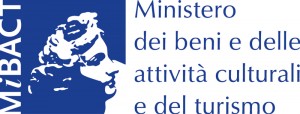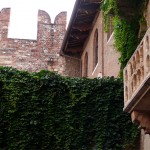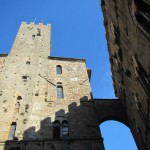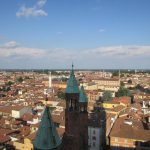No matter what, Verona is first of all the city of Romeo and Juliet!
The ancient city of Velia
Visit this incredibile archaeological site with its stunning Rosa Gateway
by Syusy Blady
The original Greek name of the Archeological site of Velia was Elea and it turned into Velia in Roman times. The best way to reach Velia is probably by train. Here you can see the tower, built in medieval times above the ancient Velia, which has a truly amazing story that tells us precisely what happened during the sea battles.
Proceed with order: having reached the medieval tower I can now admire from above the place where the Greek population of Phocians arrived here after a long pilgrimage. According to Herodotus, the Phocians were the first to navigate over long distances and they even managed to reach Tartessos (i.e. Andalusia). Their boats were well suited for navigation: the classic elongated boats of the Sea Peoples, with a sail and 50 rowers. They established bases in many parts of the Mediterranean Sea, but they had always returned to Phocaea. One day there was a war waiting for them over there. The Medes (i.e. the Persians) were conquering many lands and were also coming towards the coast. What could they do? The Phocians built some impressive walls that unfortunately did not keep Harpagus, the commander of the Mede, away. He reached the walls and captured the city. The Phocians asked for a day and a night to think about surrendering or not, but in the morning when the Medes entered the city no one was there anymore. The Phocians had all left on their boats… Thee Phocians sailed towards Greece and reached Delphi, where they asked the famous Pythia where they should go. The Pythia replied: Look for Cirno! What? Perhaps she meant Corse. In fact Corse was where they had previously founded Aleria.
Meet Parmenides
Alalia was a port already founded by the Phocians, who many decades before had set a strategy towards the northern Mediterranean, founding Marseille around the 600 B.C. and Alalia (currently Aleria). They had expanded and they were terrible! Then they begun to build a temple, becoming sedentary… which is not a good thing for Etruscans! It became an absolute critical matter. As a consequence the Etruscans decided to ally with the Carthaginians, and start a fight, probably between 540 and 535 b.C. That is the famous Battle of Alalia. The Phocians failed and were exterminated. The last surviving boat made their way to the south and they settled here in Velia. Here they built a temple dedicated to their patron goddess: Athena. Velia, founded by the exiles Phocians, became a very important centre, as testified by the remains preserved at the museum.
Velia is also remembered because here flourished a pre-Socratic philosophical school, the Eleatic school, founded by the great philosopher Parmenides. He had a revolutionary perception of what belongs to us the most, the being. Parmenides said: “It is necessary to speak and to think what is; for being is, but nothing is not”. A rather modern concept: the universality of Being, the understanding that all is one. His thought was overtaken by Plato and Aristotle, but between the late VI century and V century b.C. he was pure avant-garde!
The Rosa Gateway (Porta Rosa)
On the road that leads us to the famous Porta Rosa at Velia, there is a theatre originally built by the Phocians, partly carved into the rock, partly on the ground. Then a few boulders were added and subsequently used to build the castle. I go down the high road that starts from the hill and goes toward the sea, until I reach the Porta Rosa, discovered in the 60s by the archeologist Mario Napoli.

Porta Rosa
This door is very interesting because it’s a city gate, but also a raising part used to pass over the road and make it possible for the Walls to continue. It divides two sides of the mountain, a unique place. But the remarkable thing is that it is actually not a door, but a viaduct, an engineering undertaking with two arches, one above the other. At the en of IV century b.C. they had to join, but at the same time keep them separated, these two sides between whom there was a narrow gorge. There are a few letters that still distinguish these stones, you can see some Eta and some Epsilon. All this was perfectly preserved because shortly after its completion in the III Century, everything has been buried, until the archeologists 50 years ago brought them back to light. It looks like it has just been rough-hewed! The exciting thing is that actually these are very recent discoveries: like one could get here and, as Schliemann, discovers the Lions Gate! This is still possible in our Magna Grecia, a land of extraordinary discoveries, right on our doorstep!
⇒ Watch the full web serie Archaeological slow tour with Mibact
Cover pic courtesy of Flickr User Gianfranco Vitolo
Visit Velia – Elea official web-site
Visit Naples: helpful hints
Italian name: Napoli
Arrival
Naples has its own international airport, connected to the city centre by a bus (it takes 15 minutes and it costs 5€). For transcontinental flights you have to stop in other airports, Rome is the closest one.
Transports
In Naples you find both buses, subways and funicular. The ticket is the same for all the transports and it costs 1,5€. For more information check the ANM website. If you prefer to visit the city on foot, here you can find an idea for you tour.
What to do
Naples is the capital city of Campania region, in Southern Italy. Naples is on a beautiful Gulf, extended from the Sorrento Peninsula to the volcaninc area called Phlegrean Fields, on the background the huge Vesuvius, one of the two active volcanoes in Italy. In the Gulf, three famous islands – Capri, Ischia and Procida. The historical centre of Naples is listed as a UNESCO World Heritage Site since 1995, the most important monuments are the Dome, Palazzo Reale and the Maschio Angioino.
Speaking of food, Naples is the city where Pizza is born!
Where to sleep
The best place to sleep in Naples is of course the city centre. Other very good alternatives are Posilippo and Vomero area, the harbor and the University area, the boardwalk and the more expensive Chiaia area.














